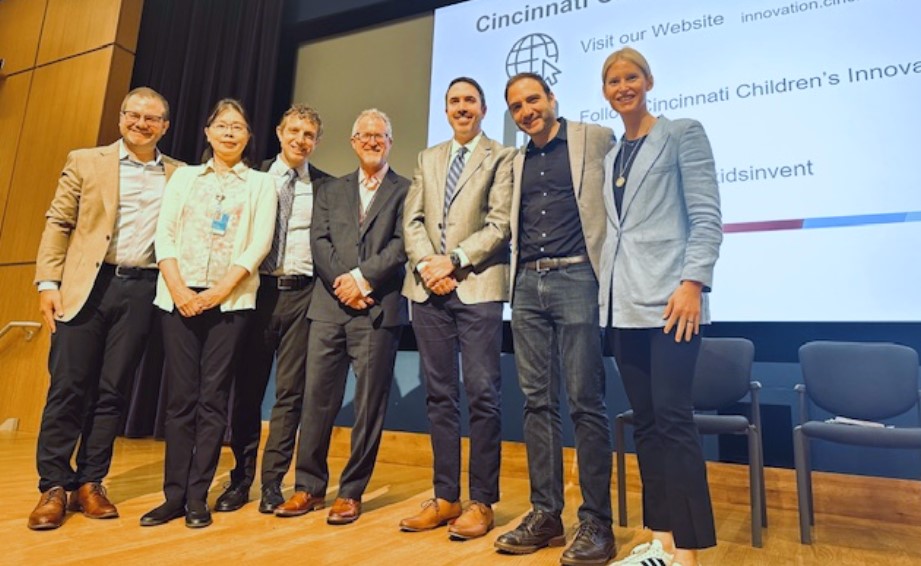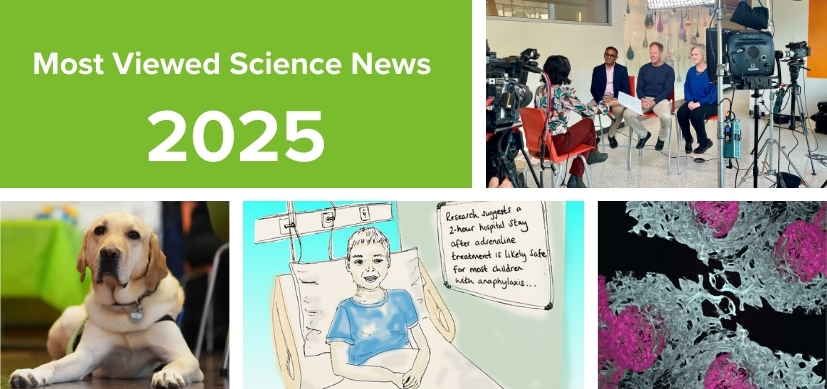Innovation and Commercialization Take Center Stage at Pediatric Grand Rounds
Post Date: July 30, 2024 | Publish Date:

Have you ever wondered what happens to ideas between that “lightbulb moment” and the time when a discovery becomes a product? On Tuesday, July 16, Cincinnati Children’s hosted an inspiring Pediatric Grand Rounds event focused on biomedical innovation and commercialization. Participants learned about the convergence of the medical and business worlds in the commercialization process.
Todd Ponsky, MD, chief innovation officer at Cincinnati Children’s, kicked off the event. Ponsky emphasized the importance of innovation in pediatric healthcare and discussed his plan to redesign innovation at Cincinnati Children’s.
“We want to catalyze new discoveries to improve child health globally,” Ponsky said.
When discussing the challenges of making innovation programs sustainable, he revealed that around the world, the vast majority of academic medical centers who attempt to commercialize innovations lose money. “It is not sustainable, and that is why we’re seeing innovation programs getting shut down in rough times,” he noted.
Emma Off, JD, CEO, president and partner at CincyTech, shared insights on what investors are looking for in healthcare innovations. Despite comparatively low investments in biotech and medtech in Ohio, life science employers continue to return to our state for efficient and reliable access to talent, sites, and support.
Off described the importance of market potential in the opportunities investors are evaluating. “We’re looking for novel, defensible IP – ideas that no one else has come up with that are protectable by a patent,” she said.
Off also emphasized the challenging fundraising environment, advising innovators to “think big” and focus on addressing significant market needs.
Next up, five Cincinnati Children’s faculty members shared their own inspiring innovation stories:
- Joe Real, MD, MEd, associate professor in the Division of General and Community Pediatrics, shared how virtual reality can be used to improve clinician communication skills for addressing vaccine hesitancy, behavioral health, and firearm safety. His work incorporates adult learning theory and has shown great results in training clinicians. They are now considering using AI to scale. “We are hoping, through our work, to really learn where automation is necessary and where that investment in human capital is really critical to address these threats to childhood health,” Real explained.
- Stu Goldstein, MD, FAAP, FNKF, a professor in the Division of Nephrology and Hypertension, the medical director of Pheresis Service and co-director of the Heart Institute Research Core, discussed the commercialization of the renal angina index (RAI) for predicting acute kidney injury (AKI). This index helps with early care decisions regarding the use of the NGAL biomarker for AKI. Goldstein highlighted the impact of their innovation: “We published a very conservative cost savings per patient of $12,500 per patient who ultimately received acute dialysis.”
- Kevin Dufendach, MD, MS, a clinical informaticist and associate professor in the Divisions of Biomedical Informatics and Neonatology, presented a NICU digital whiteboard software for harmonizing hospital flow. He showed a demonstration of the product, which offers a snapshot of the unit and allows for real time updates. Dufendach shared user feedback, quoting, “I can’t imagine working in a unit without this, this whiteboard has been incredibly helpful to all the teams that utilize it.”
- Ying Sun, PhD, a professor in the Division of Human Genetics, introduced a central nervous system-accessible molecular chaperone for treating acid beta-glucosidase-related diseases. She explained the motivation behind her work, saying, “We hope our technology will address these unmet medical needs to help the patients with Gaucher and Parkinson’s disease.”
- Ryan Moore, MD, MSc, director of Digital Health Innovation in the Heart Institute and Department of Information Services, presented on Surgeons Without Borders, a global tech initiative using virtual reality for surgical planning. “Our grand vision was to create a real-time network where healthcare teams can collaborate and seek guidance on their most complex cases anywhere in the world and on any device,” he described. Moore also discussed how time zones and language barriers in the “mediverse” can be easily overcome for the benefit of patients.
Ponsky summed up the spirit of the event, encouraging innovators to overcome the “status quo bias” and take risks to drive meaningful change in pediatric healthcare. As these inspiring talks demonstrated, Cincinnati Children’s is at the forefront of fostering an innovative mindset among its staff and advancing pediatric healthcare through cutting-edge research and technology.
This grand rounds event is available on-demand through the Cincinnati Children’s Office of CME and health care professionals can qualify for continuing education credit.
Watch a recording of this event






